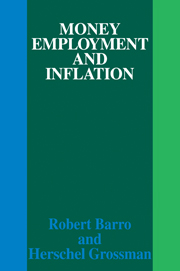Book contents
- Frontmatter
- Contents
- Dedication
- Preface
- Introduction
- 1 The basic model
- 2 Output and employment under non-market-clearing conditions
- 3 Capital, financial assets, and the rate of return
- 4 Inflation and rates of return
- 5 Inflation and unemployment
- 6 The dynamics of aggregate demand
- 7 Output and employment with wage and price speculation
- References
- Index of names
5 - Inflation and unemployment
Published online by Cambridge University Press: 07 October 2011
- Frontmatter
- Contents
- Dedication
- Preface
- Introduction
- 1 The basic model
- 2 Output and employment under non-market-clearing conditions
- 3 Capital, financial assets, and the rate of return
- 4 Inflation and rates of return
- 5 Inflation and unemployment
- 6 The dynamics of aggregate demand
- 7 Output and employment with wage and price speculation
- References
- Index of names
Summary
This chapter shifts the analytical focus to the market for labor services and considers in detail the coincident behavior of the rate of change of wages and the level of employment. Section 5.1 discusses the concepts of wage inflation, underemployment, and unemployment within the context of a single labor market as developed in the preceding chapters. Section 5.2 generalizes this analytical framework by introducing heterogeneous labor services and deriving a richer model of the coincident behavior of unemployment and wage inflation. Sections 5.3, 5.4, and 5.5 expand this model to consider the implications of asymmetrical wage response, gradual adjustment of measured unemployment, and inflationary expectations.
Wage inflation, underemployment, and unemployment in a single labor market
The analysis developed in chapter 2 above considered the relations between the quantities of labor services demanded and supplied, the rate of change of nominal wages, and the level of employment. Let us briefly review the results of this analysis. Figures 2.8–2.11 illustrate effective market-clearing loci for labor services, labeled ld′ = ls and ld = ls′. These loci divide (M/P, W/P) space into a region of excess labor demand to the right and a region of excess labor supply to the left. In the excess demand region employment equals the quantity supplied, whereas in the excess supply region employment equals the quantity demanded.
Figures 2.9 and 2.11 illustrate iso-employment loci. The maximum employment level l⋆ coincides with the unique combination of M/P and W/P which is consistent with general market clearing.
- Type
- Chapter
- Information
- Money Employment and Inflation , pp. 188 - 210Publisher: Cambridge University PressPrint publication year: 1976



